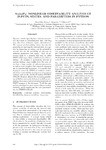Mostrar o rexistro simple do ítem
StrikePy: Nonlinear observability analysis of inputs, states, and parameters in Python.
| dc.contributor.author | Rey Rostro, David | |
| dc.contributor.author | Villaverde, Alejandro | |
| dc.date.accessioned | 2022-09-05T13:18:09Z | |
| dc.date.available | 2022-09-05T13:18:09Z | |
| dc.date.issued | 2022 | |
| dc.identifier.citation | Rey Rostro, D., F. Villaverde, A. (2022) StrikePy: Nonlinear observability analysis of inputs, states, and parameters in Python. XLIII Jornadas de Automática: libro de actas, pp.430-435. https://doi.org/10.17979/spudc.9788497498418.0430 | es_ES |
| dc.identifier.isbn | 978-84-9749-841-8 | |
| dc.identifier.uri | http://hdl.handle.net/2183/31455 | |
| dc.description.abstract | [Abstract] Dynamic models typically have unknown parameters that must be estimated from data, and they may also have unknown inputs (disturbances). The concept of observability, which describes the possibility of inferring the internal state of a system by measuring its output, can be extended to account also for the possibility of inferring its unknown parameters and inputs. Such an extension leads to a property that may be called FISPO (Full Input, State, and Parameter Observability). Its analysis is particularly relevant in systems biology, since models from this area often have a large number of unknown parameters, as well as state variables that cannot be measured due to experimental limitations. It is usually challenging to assess the FISPO of nonlinear models, which has motivated the development of specialized software such as the MATLAB toolbox STRIKE-GOLDD. However, despite the increasing popularity of Python among the biological modelling community, there was a lack of computational tools for FISPO analysis in this language. To fill this gap, we have developed an open source software toolbox, StrikePy, which implements the core functionalities in STRIKE-GOLDD. | es_ES |
| dc.description.abstract | Ministerio de Ciencia e Innovación; 10.13039/501100011033 | es_ES |
| dc.description.sponsorship | This work has received funding from MCIN/AEI/10.13039/501100011033 through grant PID2020-113992RA-I00 (PREDYCTBIO), from the Xunta de Galicia, Consellería de Cultura, Educación e Universidade through grant ED431F 2021/003, and from grant RYC-2019-027537-I funded by MCIN/AEI/10.13039/501100011033 and by “ESF Investing in your future”. | es_ES |
| dc.description.sponsorship | Ministerio de Ciencia e Innovación; 10.13039/501100011033 | es_ES |
| dc.description.sponsorship | Xunta de Galicia; ED431F 2021/003 | es_ES |
| dc.language.iso | eng | es_ES |
| dc.publisher | Universidade da Coruña. Servizo de Publicacións | es_ES |
| dc.relation.uri | https://doi.org/10.17979/spudc.9788497498418.0430 | es_ES |
| dc.rights | Atribución-NoComercial-CompartirIgual 4.0 Internacional (CC BY-NC-SA 4.0) https://creativecommons.org/licenses/by-nc-sa/4.0/deed.es | es_ES |
| dc.rights.uri | http://creativecommons.org/licenses/by-nc-sa/3.0/es/ | * |
| dc.subject | Nonlinear systems | es_ES |
| dc.subject | Observability | es_ES |
| dc.subject | Identifiability | es_ES |
| dc.subject | Dynamic modelling | es_ES |
| dc.subject | Biosystems | es_ES |
| dc.title | StrikePy: Nonlinear observability analysis of inputs, states, and parameters in Python. | es_ES |
| dc.type | info:eu-repo/semantics/conferenceObject | es_ES |
| dc.rights.access | info:eu-repo/semantics/openAccess | es_ES |
| UDC.startPage | 430 | es_ES |
| UDC.endPage | 435 | es_ES |
| dc.identifier.doi | https://doi.org/10.17979/spudc.9788497498418.0430 | |
| UDC.conferenceTitle | XLIII Jornadas de Automática | es_ES |






